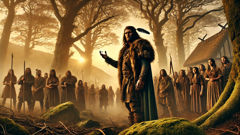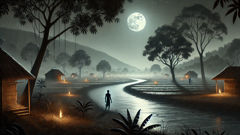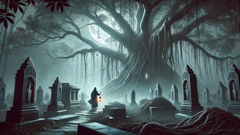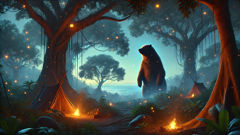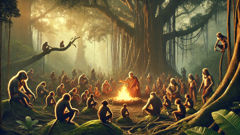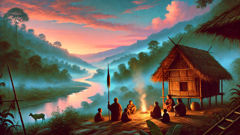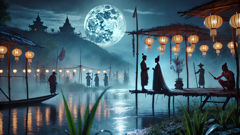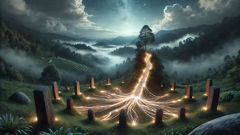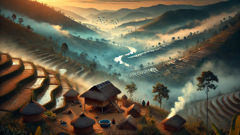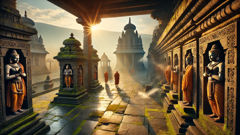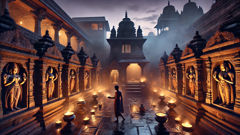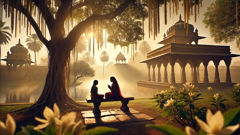Introduction
Across the windswept plains and deep green forests of ancient Scandinavia, legends were born in the flicker of firelight and the hush of twilight. Among the oldest and most enduring tales is that of King Dan, the figure whose name would echo down through centuries and come to define a people and a land. In a time before Denmark bore its name, the land was a patchwork of scattered tribes—each with their own chieftain, customs, and stories. The world was wilder, thick with ancient trees and hidden spirits, where humans lived at the mercy of the elements and the shifting tides of fate. It was an age of uncertainty, where alliances were fragile and threats loomed from both nature and neighboring lands. Amid these challenges, whispers began to travel: of a leader born beneath a blood-red sky, marked by a raven’s feather at birth, destined to gather the tribes and forge a lasting kingdom. That leader was Dan—a man whose courage and cunning would change the shape of history. He was not born into power but earned it, rising from humble origins in a coastal village battered by salt winds and restless seas. From his earliest days, Dan displayed a keen sense of justice and an unyielding bravery that set him apart. He listened more than he spoke, and when he did speak, his words carried a gravity that made others lean in. When storms tore through the land or wild beasts threatened the people, Dan was always the first to respond, standing firm when others faltered. As he grew, so too did his legend. The elders told of omens and dreams—of wolves running at his side, of an ancient sword unearthed beneath the roots of a sacred oak. Some said he could speak to the spirits of the forest, others that the gods themselves guided his hand. Yet it was Dan’s actions, not the rumors, that truly set him apart. In an age when kinship ties often ended at the edge of the village, Dan ventured forth to neighboring tribes, not with threats, but with open hands and promises of shared strength. Slowly, tribe by tribe, he wove together a fragile unity. But darkness was never far away. Raiders from the south and east saw only division and weakness, and the tribes faced growing threats. It was in the crucible of these challenges that Dan’s true mettle would be tested, as he led his people through battles both physical and spiritual, and laid the foundations for a nation that would bear his name.
The Gathering of Tribes
In those days, the land that would become Denmark was a quilt of villages, each fiercely proud and wary of outsiders. The elders remembered winters so harsh that even the wolves starved, and summers when the sun barely set and shadows never lingered long. Each clan had its own gods, its own taboos, and its own scars from generations of feuding. It was not unusual for blood to be spilled over hunting rights or insulted honor. To unite these people would require more than brute strength—it needed vision, patience, and the ability to inspire hope where there had been only caution. Dan understood this better than anyone. He traveled far and wide, guided by the stars and ancient trails known only to the oldest hunters. In each village, he arrived not as a conqueror but as a guest. He listened to their woes by smoky hearths and helped mend fences, both literal and metaphorical. Where disputes threatened to spill into violence, he became a mediator, urging peace and offering fair judgments that surprised even the most cynical. It was during the midsummer moot at the great clearing of Lindholm that Dan made his boldest move. For generations, the tribes had gathered here for trade and ritual, but rarely had they spoken as one. This year, Dan called for something more: a council to decide the future not just of their own kin, but of all who called this land home. Some scoffed, but curiosity drew others. They watched as Dan stood before them, not dressed in royal finery but in the simple garb of a woodsman, a sword at his hip and the raven feather in his hair. He spoke of the dangers that threatened them all—raiders from the sea, hunger in lean years, the slow encroachment of foreign customs. But he also spoke of possibilities: shared harvests, stronger defenses, and the wisdom that came from many voices, not just one. It was a gamble, but Dan’s words had weight. Slowly, tribal leaders stepped forward—first one, then another—willing to at least hear him out. That night, as the bonfires sent sparks into the sky and stories wove between laughter and song, a fragile pact was formed. It would take more than a single council to make it last. Over the coming months, Dan traveled endlessly between villages, helping with harvests, hunting parties, and defense. He was seen lifting stones for new longhouses, tending to wounded warriors, and teaching children the old songs. Little by little, loyalty to Dan grew—not out of fear, but out of respect. And as winter approached, when the first true test came in the form of a sudden raid from across the sea, it was Dan who rallied the scattered warriors and led them to victory beneath a sky swirling with northern lights. The tribes had found a leader. The land had found its heart.
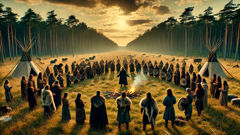
The Beast of the Mists
No legend is complete without its monsters, and for the people of ancient Denmark, the greatest terror was not man but beast. Deep within the marshlands and fens, stories spoke of a creature known as Grendel’s Shadow—a monstrous form with eyes like embers and a howl that could freeze blood. For generations, mothers warned their children not to stray far when the mists rolled in from the sea. Cattle disappeared, hunters returned pale and shaken, and sometimes, entire families vanished without a trace. When peace among the tribes was still fresh and fragile, it was this beast that threatened to unravel everything Dan had worked for. One autumn evening, as fog crept over the land like a living thing, word reached Dan’s hall of a village lost to the mists. The survivors spoke in broken whispers of claws tearing through doors and a darkness that moved with purpose. The elders gathered in fear. Some wanted to abandon the marshlands altogether; others argued it was punishment from the gods for meddling with old ways. But Dan stood firm. He vowed to hunt the beast—not only to save the people but to prove that unity could overcome even the oldest fears. He gathered a band of warriors—men and women from different tribes, each skilled in their own way. They moved by night, guided by the stars and Dan’s uncanny sense for hidden paths. The marsh was a world apart: reeds taller than a man, pools that swallowed sound, will-o’-the-wisps dancing on the edge of sight. For days they tracked the beast, finding only its prints—huge and twisted—until finally, deep in the heart of the fens, they came upon the creature itself. It was larger than any bear, its fur matted and dark as peat, with eyes that glowed red in the torchlight. The fight was brutal. Many were wounded, but Dan pressed on, wielding the ancient sword he’d unearthed as a boy. At last, with a roar that echoed across the water, he struck the beast down. The marsh fell silent. The warriors built a pyre for the fallen and carried back tales of courage that would be sung for generations. For the first time, the tribes believed that together they could face anything, even the shadows of their oldest nightmares.
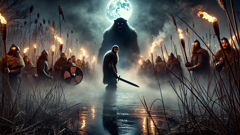
The Birth of a Nation
With Grendel’s Shadow slain, the unity Dan had forged became more than a pact—it was now sealed in shared trial and triumph. As word of his deeds spread, more tribes sought his counsel and protection. Where once there had been suspicion, there was now respect. Yet Dan knew that unity needed more than shared enemies; it needed symbols and customs that could bind people together long after memories faded. He called for another great moot, this time on the high bluffs overlooking the sea. It was here that the first stones of what would become Denmark’s heart were laid. Elders from every tribe brought offerings: carved wooden totems, woven banners, and the first seeds for a shared harvest. A council was formed, not to erase old traditions but to blend them. Old gods and new were honored side by side; songs from distant valleys joined in new harmonies. Dan oversaw the forging of new laws—simple but fair—carved into oaken tablets. They spoke of hospitality to strangers, justice for the weak, and loyalty to the land above all. The name "Danmark" was first spoken here: the borderland of Dan and his people. Over time, the villages grew into towns. Where there had been only mud and timber rose halls of stone and sturdy bridges. Trade flourished, and the people began to see themselves not just as members of tribes, but as Danes. But unity was tested by more than monsters or raiders. In one bitter winter, famine struck. The grain stores ran low, and wolves prowled ever closer to human dwellings. Dan traveled from settlement to settlement, organizing food sharing and rationing. He led hunting parties himself, enduring hunger alongside his people. His leadership through hardship cemented his legend—he became not just a king, but a father to his nation. As spring returned and fields grew green again, the people gathered on the bluffs for a festival. There they named Dan their king—not by force, but by acclamation. A simple circlet of bronze was placed upon his brow, and the people chanted his name. Denmark was born.
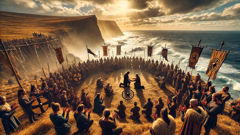
Conclusion
The story of King Dan is more than a tale of one man—it’s the story of a people finding purpose and identity in unity. Through courage in the face of the unknown, compassion across old boundaries, and wisdom in forging something greater than oneself, Dan’s legacy became the bedrock of a nation. His name lives on, woven into every corner of Denmark’s rolling hills and bustling cities. Legends say that when Denmark faces its darkest hours, the spirit of King Dan still watches over his people, a silent guardian from the ancient forests and windswept coasts. In every act of kindness, every gathering of friends, and every song sung beside a fire, the echo of that first king’s vision endures. And so, through seasons of hardship and triumph, the legend of King Dan reminds us: true greatness is not born in solitude or conquest, but in the courage to bring people together and build something lasting from the dreams of many.

